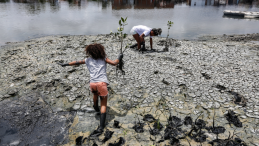Cities, increasingly vulnerable to climate change and disasters due to dense populations and socio-economic disparities, are crucial for sustainable development. With 70 million people moving to urban areas in the developing world annually, many cities struggle to provide adequate, sustainable infrastructure and inclusive access to services. However, through community engagement, nature-based solutions, innovative governance and digitalization, some cities are becoming models of resilience and sustainability.
Here are five cities around the world that serve as exemplary models:
Bonn, Germany: Raising climate ambitions by understanding and tracking knowledge and perceptions
Bonn, a city of over 300,000 inhabitants, is an international hub for sustainable urban development and climate action aiming for climate neutrality by 2035. To this end, a large number of activities are supported by funding programmes — such as construction or energy measures and green infrastructure — to mitigate natural hazards like floods and heatwaves.
Participation is key: a Climate Action Plan was developed with input from citizens, civil society and businesses. "Climate districts" are being established to involve residents and regular surveys track public knowledge and perception of climate action measures.
Buenos Aires, Argentina: Empowering informal settlements through participatory processes
In Argentina’s capital, 10 per cent of the urban population resides in informal settlements, which amounts to over 300,000 people. Hence, upgrading processes are needed that are both participatory and climate-friendly to ensure sustainability. Transformative Urban Coalitions (TUC), supported by UNU-EHS, established an Urban Lab in a quarter called Barrio 20, capitalizing on pre-existing community structures in which local initiatives are planned and implemented. The lab uses these structures for initiatives such as greening a schoolyard and setting up a temperature and humidity monitoring system.
The urban lab quickly integrated into the neighbourhood’s upgrading process, fostering local commitment and ownership. Villa 20 shows how participatory local actions can create more liveable, greener and socially just communities.
Hue, Viet Nam: Strengthening resilience to rising floods through risk-informed adaptation
Hue, a coastal city in Central Viet Nam, faces increasing flood risks. To strengthen its resilience, Hue initially focused on physical flood control infrastructure like dams, flood gates and drainage systems along with early warning systems through sirens and mobile apps. More recently, nature-based solutions, such as mangroves to reduce coastal flooding impacts, were applied and proved very beneficial.
UNU-EHS is part of the FloodAdaptVN project, which contributes to Hue’s resilience-building efforts, for instance by assessing key flood risks and people's needs of and attitudes towards flood risks adaptation solutions. Results are discussed with local stakeholders to jointly identify and evaluate additional resilience-building options, including more nature-based solutions and improved early warning systems.
Nairobi, Kenya: Assessing capacities and needs in support of the most vulnerable urban dwellers
Nearly 60 per cent of Nairobi’s 4.4 million inhabitants live in informal settlements, with Kibera being the largest in Kenya and one of the largest in Africa. Inhabitants are increasingly suffering from growing climate change impacts and natural hazards.
While NGOs and state actors provide support, it is insufficient to keep pace with growing populations and risks. Community-driven initiatives and local actions are crucial for sustaining livelihoods during and after disasters. Local data collection and assessments, including mapping disaster impacts such as losses and damages of housing, health and financial security, is essential. A UNU-EHS study highlighted local needs and capacities, linking them to international debates around operationalizing the “Loss and Damage Fund” to address unavoidable climate change effects.
Visakhapatnam, India: Achieving a more sustainable city through innovation and technology
Visakhapatnam, a rapidly growing city of 2.3 million on India’s cyclone-prone eastern coast, uses technology to address complex urbanization issues and improve the quality of life while enhancing participatory urban governance.
Pluvial flooding is a major challenge, worsened by the city’s hilly terrain. The ‘sachivalyam’ system, a volunteer-based initiative, is being expanded to train volunteers as first responders and community voices. Equipped with app-based monitoring and information collection systems, these volunteers provide regular updates to Visakhapatnam Smart City’s central command and control centre, enabling swift, proactive measures. The T-CAP project led by UNU-EHS supports this approach through an urban living lab where residents and volunteers collaborate on climate actions such as vulnerability and risk clustering, action prioritization and disaster risk management. This helps to prioritize interventions based on smart city data.





